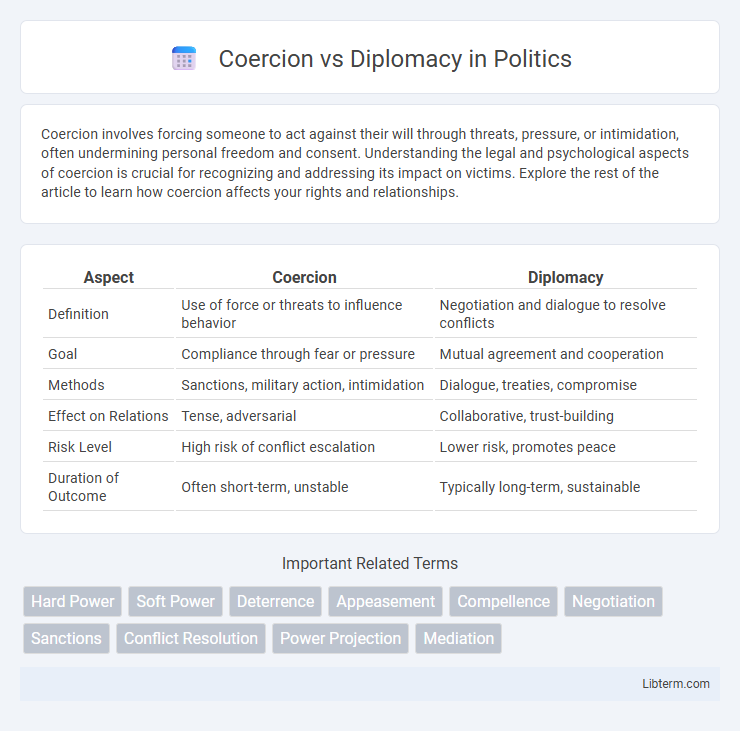Coercion involves forcing someone to act against their will through threats, pressure, or intimidation, often undermining personal freedom and consent. Understanding the legal and psychological aspects of coercion is crucial for recognizing and addressing its impact on victims. Explore the rest of the article to learn how coercion affects your rights and relationships.
Table of Comparison
| Aspect | Coercion | Diplomacy |
|---|---|---|
| Definition | Use of force or threats to influence behavior | Negotiation and dialogue to resolve conflicts |
| Goal | Compliance through fear or pressure | Mutual agreement and cooperation |
| Methods | Sanctions, military action, intimidation | Dialogue, treaties, compromise |
| Effect on Relations | Tense, adversarial | Collaborative, trust-building |
| Risk Level | High risk of conflict escalation | Lower risk, promotes peace |
| Duration of Outcome | Often short-term, unstable | Typically long-term, sustainable |
Understanding Coercion and Diplomacy
Coercion involves the use of threats or force to influence another party's behavior, leveraging power asymmetries and potential consequences to achieve compliance. Diplomacy relies on negotiation, dialogue, and mutual understanding to resolve conflicts and build lasting agreements without resorting to violence. Effective conflict resolution often requires balancing coercive measures with diplomatic efforts to maintain stability and promote cooperation.
Historical Roots of Coercion and Diplomacy
Coercion and diplomacy have evolved from ancient civilizations where military force and negotiation played pivotal roles in shaping empires and alliances. Coercion finds its roots in the wielding of power through threats or force, evident in the conquests of empires like Rome and the Mongols, while diplomacy emerged as a structured practice in city-states such as Athens and later in the intricate treaty systems of Renaissance Europe. Understanding these historical foundations highlights how coercion often secured immediate compliance, whereas diplomacy fostered long-term cooperation and international order.
Key Differences Between Coercion and Diplomacy
Coercion relies on the use or threat of force to influence another party's behavior, emphasizing power and intimidation, whereas diplomacy prioritizes negotiation, dialogue, and mutual understanding to achieve peaceful resolutions. Coercion often results in compliance driven by fear, while diplomacy fosters cooperation and long-term relationships through trust and compromise. Key differences include coercion's reliance on unilateral pressure contrasted with diplomacy's emphasis on bilateral or multilateral engagement and consensus-building.
Tools and Strategies of Coercion
Tools and strategies of coercion primarily involve the use of threats, economic sanctions, military pressure, and cyber operations to compel adversaries to change their behavior without direct conflict. These methods leverage power asymmetry and the credible risk of punishment to influence decision-making and deter unfavorable actions. Coercion also relies on signaling resolve and maintaining ambiguity to create uncertainty and fear, thereby maximizing psychological impact and strategic leverage.
Methods and Tactics of Diplomacy
Diplomacy employs methods such as negotiation, dialogue, and compromise to resolve conflicts and build mutually beneficial relationships between states. Tactics include confidence-building measures, back-channel communications, and the use of international organizations to facilitate cooperation and peaceful dispute resolution. These approaches contrast with coercion, relying on persuasion and incentives rather than threats or force to achieve foreign policy goals.
The Role of Power in Coercion vs Diplomacy
Power dynamics fundamentally shape both coercion and diplomacy, where coercion relies on the explicit use or threat of force to compel compliance, while diplomacy leverages influence through negotiation and mutual benefit. In coercion, the dominant party exercises superior military, economic, or political power to impose its will, whereas diplomacy depends on soft power, including cultural influence and strategic alliances, to foster cooperation. Effective statecraft balances hard power and soft power, recognizing that coercion may provoke resistance, while diplomacy seeks sustainable outcomes through persuasion and compromise.
Case Studies: Coercion in International Relations
Coercion in international relations involves the use of threats or limited force to influence another state's behavior, as demonstrated by the Cuban Missile Crisis where the United States successfully compelled the Soviet Union to remove nuclear missiles from Cuba through a naval blockade and clear military warning. Another case study is the Gulf War of 1990-1991, where the U.S.-led coalition employed overwhelming military force to expel Iraqi troops from Kuwait, exemplifying coercion by demonstrating credible threats and willingness to act. These instances highlight coercion as a strategic tool relying on the credible threat of punishment to achieve political objectives without full-scale war.
Case Studies: Successes Through Diplomacy
The Cuban Missile Crisis exemplifies success through diplomacy where the U.S. and USSR negotiated a peaceful resolution, avoiding nuclear conflict. The Camp David Accords between Egypt and Israel demonstrated effective diplomatic engagement resulting in a historic peace treaty. These cases show diplomacy's strength in achieving sustainable outcomes without resorting to coercion or military action.
Long-term Impact: Coercion vs Diplomatic Solutions
Coercion often results in resentment and unstable agreements, undermining long-term peace and cooperation between parties. Diplomatic solutions foster trust, mutual understanding, and sustainable partnerships that contribute to lasting stability and economic growth. Historical data shows that diplomatic resolutions have significantly higher success rates in maintaining peaceful international relations over decades.
Choosing the Right Path: When to Use Coercion or Diplomacy
Choosing between coercion and diplomacy depends on the nature of the conflict, the goals of the parties involved, and the potential consequences of each approach. Coercion is effective in situations requiring immediate compliance or when power asymmetry favors the coercing party, while diplomacy thrives in maintaining long-term relationships and mutual understanding. Assessing the balance of power, urgency, and desired outcome helps determine whether coercion or diplomacy will achieve the best strategic advantage.
Coercion Infographic

 libterm.com
libterm.com